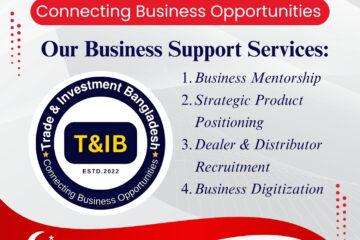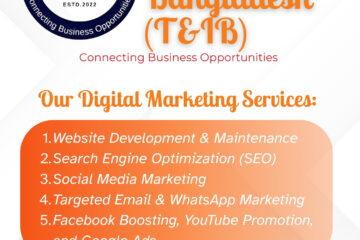Top 10 Methods to Attract More Traffic to Your Website
Md. Joynal Abdin*
Business Consultant & Digital Marketer
Co-Founder & CEO of Bangladesh Trade Center
In today’s digital age, a website serves as the virtual gateway to a business, organization, or individual. It acts as a powerful medium to showcase products, services, ideas, and content to a global audience. However, merely having a website is not enough to thrive in the competitive online landscape. To succeed and make a meaningful impact, attracting more traffic to your website is paramount. Why you should invest to attract more traffic into your website? It is because –
- The Virtual Highway of Opportunities: A website with high traffic is like a bustling city with endless opportunities. Each visitor represents a potential customer, client, or supporter. More traffic equates to more leads, conversions, and revenue-generating opportunities. Whether you are running an e-commerce store, a blog, a service-based business, or a non-profit organization, increasing your website’s traffic can lead to tangible and intangible benefits.
- Enhanced Visibility and Brand Awareness: Attracting more traffic to your website enhances your online visibility and brand awareness. When people discover and engage with your website, they become familiar with your brand, products, or services. Over time, this fosters trust and credibility, encouraging them to choose your offerings over competitors.
- Boosting Search Engine Rankings: Search engines like Google, Bing, and Yahoo are the primary tools people use to find information, products, or services online. Attracting more traffic signals search engines that your website is relevant and valuable to users. As a result, your website’s search engine rankings improve, further increasing its exposure to potential visitors.
- Amplifying Content Reach: Compelling content lies at the core of attracting traffic. As more visitors access your content, the likelihood of them sharing it with others increases. This natural word-of-mouth marketing expands your content’s reach far beyond your immediate network. A viral piece of content can catapult your website’s traffic to new heights and create lasting impacts.
- Unleashing the Power of Conversion: Website traffic is not solely about numbers; it’s about turning visitors into customers or supporters. Through effective calls-to-action, user-friendly design, and engaging content, you can optimize your website for conversions. More traffic means more potential customers in your sales funnel, leading to increased conversions and revenue growth.
- Valuable Market Insights: Every website visitor provides an opportunity to gather valuable data and insights. Analyzing website traffic patterns, user behavior, and preferences can help you refine your marketing strategies, improve user experience, and develop targeted campaigns. These insights enable you to make data-driven decisions that align with your audience’s needs and preferences.
- Staying Ahead of Competitors: In today’s hyper-competitive digital landscape, attracting more traffic is not a luxury; it’s a necessity. Your competitors are likely investing in strategies to increase their website traffic, and to stay ahead, you must do the same. Building a strong online presence and attracting a steady stream of visitors is crucial for establishing your authority and outperforming your rivals.
Top 10 Methods to Attract More Traffic to your Website:
- Search Engine Optimization (SEO): Optimize your website for search engines to improve its visibility in organic search results. Target relevant keywords, create high-quality content, and build authoritative backlinks to attract more visitors.
- Content Marketing: Create valuable and engaging content such as blog posts, articles, videos, infographics, and podcasts. Content marketing can attract and retain visitors, as well as encourage them to share your content, driving more traffic to your site.
- Social Media Marketing: Leverage popular social media platforms to promote your content and engage with your audience. Share updates regularly, participate in discussions, and use visuals to capture attention.
- Email Marketing: Build and nurture an email list to keep your audience informed and engaged. Send newsletters, exclusive offers, and updates to drive traffic to your website.
- Guest Blogging: Write guest posts for other websites in your niche or invite guest bloggers to contribute to your site. This cross-promotion can help you reach new audiences and build valuable backlinks.
- Influencer Marketing: Collaborate with influencers or industry experts who have a significant following. Their endorsement can introduce your website to a broader audience and drive traffic.
- Online Advertising: Invest in paid advertising on platforms like Google Ads, Facebook Ads, or other social media channels. Paid ads can provide an immediate boost in traffic and help you target specific audiences.
- Video Marketing: Utilize video content on platforms like YouTube to engage users visually and drive traffic back to your website. Video content often performs well and can be shared across various platforms.
- Optimize Website Performance: Ensure your website loads quickly, are mobile-friendly, and has an intuitive user interface. A positive user experience encourages visitors to explore more pages and return in the future.
- Community Engagement: Participate in online forums, social media groups, and communities relevant to your niche. Offer helpful insights, answer questions, and interact with users to establish yourself as an authority and attract traffic through word-of-mouth.
Remember that a combination of these methods often works best, and it’s essential to tailor your approach to your specific target audience and industry. Continuously monitor and analyze the performance of your strategies to make data-driven decisions for ongoing improvement.
-
Search Engine Optimization (SEO)
Search Engine Optimization (SEO) is the practice of optimizing your website and its content to improve its visibility and ranking in search engine results pages (SERPs). The ultimate goal of SEO is to attract organic (non-paid) traffic from search engines like Google, Bing, and Yahoo. By making your website more search engine-friendly, SEO increases the chances of your website being found by users searching for relevant information, products, or services. SEO involves various techniques and strategies that can be broadly categorized into two main types:
On-Page SEO: This focuses on optimizing the elements within your website itself. Here are some key on-page SEO factors:
- Keyword Research: Identify relevant keywords and phrases that your target audience is using to search for content related to your website. Tools like Google Keyword Planner, SEMrush, and Moz Keyword Explorer can help with this.
- Content Optimization: Create high-quality, relevant, and valuable content that incorporates the chosen keywords naturally. Ensure your content is well-structured, easy to read, and addresses the needs of your audience.
- Title Tags and Meta Descriptions: Craft compelling and descriptive title tags and meta descriptions that include your target keywords. These are the snippets that appear in search engine results and influence click-through rates.
- URL Structure: Create clean, descriptive, and user-friendly URLs that contain relevant keywords.
- Heading Tags (H1, H2, etc.): Use heading tags to structure your content and make it easier for search engines to understand the hierarchy of information on your page.
- Image Optimization: Optimize image file names and alt text with relevant keywords to improve their discoverability in image searches.
Off-Page SEO: This focuses on factors outside your website that influence its ranking in search engines. The most critical aspect of off-page SEO is building high-quality backlinks from reputable and relevant websites. Here are some off-page SEO strategies:
- Link Building: Acquire backlinks from authoritative websites in your industry or niche. This can be achieved through guest blogging, content promotion, influencer outreach, and more.
- Social Media Engagement: Active social media presence and engagement can help increase your website’s visibility and attract potential link opportunities.
- Online Directories and Citations: Ensure your business is listed accurately and consistently in relevant online directories and local business listings.
- Influencer Marketing: Collaborate with influencers or industry experts to gain exposure and attract more traffic to your website.
- Social Bookmarking: Share your content on social bookmarking sites to drive traffic and increase visibility.
- Online Forums and Communities: Engage in relevant online forums and communities to build relationships, share your expertise, and drive traffic through a well-placed link.
Important Tips for Successful SEO:
- Focus on user experience: Create content and design your website with the user in mind, as search engines prioritize sites that provide value to users.
- Regularly update and add new content: Fresh and relevant content attracts search engines and encourages visitors to return.
- Monitor and analyze website performance: Use tools like Google Analytics to track traffic, user behavior, and key performance indicators to refine your SEO strategies.
- Stay updated on SEO best practices and algorithm changes: Search engines continually evolve, so it’s crucial to stay informed about the latest trends and updates in SEO.
SEO is an ongoing process, and it requires dedication, patience, and continuous effort to see sustainable results. By implementing both on-page and off-page SEO techniques, you can significantly increase your website’s visibility, drive more organic traffic, and achieve long-term success in the digital landscape.
-
Content Marketing
Content Marketing is a strategic marketing approach that involves creating and distributing valuable, relevant, and consistent content to attract and engage a specific target audience. The primary goal of content marketing is to provide value to the audience, build trust, and ultimately drive profitable customer actions, such as making a purchase, subscribing to a service, or sharing the content with others. It focuses on building long-term relationships with customers by offering helpful, informative, entertaining, or inspiring content.
How to Do Content Marketing:
- Define Your Audience: Understand your target audience’s needs, preferences, and pain points. Conduct market research and create buyer personas to have a clear picture of whom you are creating content for.
- Set Clear Goals: Define specific and measurable goals for your content marketing efforts. Common goals include increasing website traffic, lead generation, brand awareness, customer retention, and conversions.
- Content Strategy: Develop a comprehensive content strategy that aligns with your business goals and audience. Decide on the types of content you will create, such as blog posts, videos, infographics, podcasts, ebooks, etc.
- Keyword Research: Conduct keyword research to identify relevant and high-traffic keywords that your target audience is searching for. Use these keywords strategically in your content to improve its visibility in search engine results.
- Create High-Quality Content: Produce valuable, informative, and well-crafted content that addresses the needs and interests of your audience. Focus on providing solutions, answering questions, and adding value.
- Diversify Content Formats: Experiment with various content formats to cater to different audience preferences. Mix written content with visuals, videos, and interactive elements to keep your audience engaged.
- Consistency and Frequency: Be consistent in publishing content and maintain a regular posting schedule. This helps build anticipation and trust with your audience.
- Promote Your Content: Share your content across different marketing channels, including social media, email newsletters, online communities, and relevant industry forums. Encourage sharing and engagement to expand your content’s reach.
- Measure Performance: Use analytics tools to track the performance of your content. Monitor metrics such as website traffic, engagement rates, conversion rates, and time spent on page to gauge the effectiveness of your content marketing efforts.
- Optimize and Repurpose Content: Continuously analyze your content’s performance and make improvements based on insights. Also, consider repurposing successful content into different formats to reach new audiences.
- Engage with Your Audience: Respond to comments, messages, and feedback from your audience. Engaging with them fosters a sense of community and loyalty.
- Stay Updated and Evolve: Keep an eye on industry trends and changes in your target audience’s behavior. Adapt your content marketing strategy accordingly to stay relevant and maintain your competitive edge.
Content marketing is a long-term strategy that requires dedication and patience. By consistently providing valuable content that resonates with your audience, you can build strong relationships, increase brand loyalty, and drive meaningful actions that benefit your business in the long run.
-
Social Media Marketing
Social Media Marketing is a digital marketing strategy that involves using social media platforms to promote products, services, or content and engage with a target audience. Social media has become a powerful tool for businesses and individuals to connect with their audience, build brand awareness, drive website traffic, and generate leads. It encompasses various activities, such as creating and sharing content, engaging with followers, running ads, and analyzing performance metrics. How to Do Social Media Marketing:
- Choose the Right Platforms: Identify the social media platforms that align with your target audience and business goals. Popular platforms include Facebook, Instagram, Twitter, LinkedIn, Pinterest, and YouTube.
- Create a Social Media Strategy: Define your objectives, target audience, tone of voice, and key performance indicators (KPIs). Develop a content plan that outlines what type of content you’ll share and when.
- Optimize Your Profiles: Create professional and consistent profiles across all chosen platforms. Use high-quality profile pictures, cover images, and a compelling bio that reflects your brand identity.
- Content Creation: Create engaging and shareable content that aligns with your audience’s interests and preferences. Content can include images, videos, infographics, blog posts, polls, and more.
- Content Calendar: Plan and schedule your content in advance using a content calendar. This ensures a consistent flow of posts and helps you stay organized.
- Community Engagement: Interact with your followers and respond to comments, messages, and mentions promptly. Engaging with your audience builds relationships and fosters loyalty.
- Incorporate Hashtags: Use relevant and popular hashtags in your posts to increase discoverability and reach a wider audience.
- Paid Advertising: Consider running paid social media advertising campaigns to target specific demographics, boost content visibility, and drive website traffic or conversions.
- Social Media Influencers: Collaborate with influencers who have a significant following in your niche to extend your brand’s reach and credibility.
- Measure Performance: Utilize social media analytics tools to track the performance of your content and campaigns. Monitor metrics like reach, engagement, clicks, conversions, and audience demographics.
- A/B Testing: Experiment with different types of content, posting times, and ad creatives through A/B testing to identify what resonates best with your audience.
- Stay Updated and Adapt: Social media platforms and trends evolve rapidly. Stay informed about platform updates and industry trends, and be ready to adapt your strategy accordingly.
- Monitor Your Competition: Keep an eye on your competitors’ social media activities to gather insights and identify opportunities for improvement.
- Avoid Over-Promotion: Strike a balance between promotional content and value-driven content. Avoid overwhelming your audience with constant sales pitches.
Social media marketing requires a mix of creativity, strategic planning, and consistency. By understanding your audience, tailoring your content, and engaging actively, you can leverage social media to build a loyal community, increase brand visibility, and achieve your marketing objectives.
-
Email Marketing
Email Marketing is a digital marketing strategy that involves using email to communicate with a target audience, promote products or services, share valuable content, and build relationships with customers or potential customers. It is a direct and personalized form of communication that allows businesses and individuals to reach their audience directly in their inbox. How to Do Email Marketing:
- Build an Email List: Start by building a permission-based email list of subscribers who have voluntarily opted in to receive emails from you. You can collect email addresses through website sign-up forms, lead magnets, events, and other opt-in opportunities.
- Choose an Email Marketing Service: Select a reliable and user-friendly email marketing service provider, such as Mailchimp, ConvertKit, AWeber, or Constant Contact. These platforms offer features like list management, email templates, automation, and analytics.
- Segment Your Audience: Divide your email list into segments based on factors like interests, purchase behavior, location, or engagement level. This allows you to send targeted and relevant content to specific groups.
- Craft Compelling Content: Create engaging and valuable email content that resonates with your audience. This can include newsletters, product updates, promotions, blog digests, or exclusive content.
- Personalization: Personalize your emails by addressing recipients by their names and tailoring content based on their preferences or behavior. Personalization helps build stronger connections with your audience.
- Optimize Email Design: Use a clean and visually appealing email design that aligns with your brand. Ensure your emails are mobile-responsive, as a significant portion of users access emails on mobile devices.
- Use Catchy Subject Lines: Write attention-grabbing subject lines that entice recipients to open your emails. Avoid using spammy or deceptive subject lines.
- Frequency and Timing: Find the right balance for email frequency, so you don’t overwhelm your audience with too many emails. Test different sending times to determine when your audience is most responsive.
- Automation: Implement email automation to send targeted emails based on triggers, such as a user’s sign-up, website activity, or purchase behavior. Automation saves time and ensures timely and relevant communications.
- Monitor and Analyze: Use email marketing analytics to track open rates, click-through rates, and conversion rates. Analyzing these metrics helps you measure the effectiveness of your campaigns and make improvements.
- A/B Testing: Experiment with different elements of your emails, such as subject lines, content, CTAs, and visuals, through A/B testing. This allows you to identify what resonates best with your audience.
- Compliance with Email Laws: Familiarize yourself with email marketing laws, such as the CAN-SPAM Act (in the United States) or GDPR (in the European Union), to ensure your email marketing is compliant with regulations.
- Provide Opt-Out Option: Always include an easy-to-find unsubscribe/opt-out link in your emails to allow recipients to opt-out if they wish.
Email marketing is a powerful tool for engaging with your audience and driving business growth. By delivering valuable content, personalizing your messages, and using data to inform your decisions, you can create effective email campaigns that nurture relationships, encourage conversions, and foster long-term customer loyalty.
-
Guest Blogging
Guest Blogging is a content marketing strategy where you write and publish articles or blog posts on other websites or blogs as a guest author. It allows you to reach a new audience, build brand awareness, establish yourself as an authority in your niche, and earn valuable backlinks to your website, which can improve your website’s search engine rankings. How to Do Guest Blogging:
- Identify Relevant Blogs: Research and find blogs or websites that are relevant to your industry or niche. Look for websites with an engaged audience and good domain authority.
- Read Guest Posting Guidelines: Before reaching out to a blog, carefully read their guest posting guidelines. Each blog may have specific requirements and guidelines for guest submissions.
- Familiarize Yourself with the Content: Read several articles on the blog to understand their writing style, tone, and topics covered. This will help you tailor your guest post to match the blog’s audience.
- Pitch Your Idea: Contact the blog owner or editor with a well-crafted pitch that outlines your proposed guest post idea. Explain how your content will benefit their audience and align with their blog’s focus.
- Write High-Quality Content: If your pitch is accepted, start writing your guest post. Focus on providing valuable and unique content that offers actionable insights or solves a problem for the readers.
- Follow Style Guidelines: Stick to the blog’s writing style, tone, and formatting requirements. Use headings, subheadings, bullet points, and images to make your content more engaging and easy to read.
- Include an Author Bio: Most guest blogging opportunities allow you to include an author bio at the end of your post. Write a brief bio that introduces yourself and includes a link back to your website or social media profiles.
- Edit and Proofread: Before submitting your guest post, thoroughly edit and proofread it for grammar, spelling, and formatting errors. A well-polished post reflects positively on your professionalism.
- Submit Your Guest Post: Submit your guest post to the blog according to their specified guidelines. Be patient, as it may take some time for the blog to review and publish your content.
- Promote Your Guest Post: Once your guest post is published, promote it on your social media channels, email newsletter, and website to drive traffic back to the blog and establish your credibility.
- Engage with the Audience: After your guest post is published, engage with the blog’s audience by responding to comments and questions. This helps you build connections with potential readers.
- Track Your Results: Monitor the performance of your guest post, such as website traffic, new followers, and backlinks. Assess the impact of your guest blogging efforts on your overall marketing strategy.
Guest blogging can be a powerful tool for expanding your reach and building authority within your industry. By offering valuable content and forming mutually beneficial relationships with other bloggers, you can maximize the benefits of guest blogging for your content marketing strategy.
-
Influencer Marketing
Influencer Marketing is a type of marketing strategy that involves collaborating with influential individuals (influencers) who have a significant following and impact in a particular niche or industry. The goal of influencer marketing is to leverage the influencer’s reach and credibility to promote products, services, or brands to their engaged audience. Influencers can be social media personalities, bloggers, YouTubers, celebrities, experts, or industry thought leaders. How to Do Influencer Marketing:
- Define Your Goals and Audience: Determine your marketing objectives and identify the target audience you want to reach through influencer marketing. This will help you choose the right influencers for your campaign.
- Research Influencers: Look for influencers who align with your brand and target audience. Consider factors like their niche, engagement rate, audience demographics, content quality, and authenticity.
- Engage and Build Relationships: Start engaging with the influencers you want to collaborate with. Follow them on social media, like and comment on their posts, and share their content to show your genuine interest.
- Reach Out with a Proposal: Send a well-crafted proposal to the influencers you want to work with. Clearly outline the details of the collaboration, such as the type of content you want them to create, campaign duration, compensation, and any specific guidelines.
- Negotiate and Agree on Terms: Be prepared to negotiate terms, such as compensation, content ownership, and performance metrics. Ensure both parties agree on all aspects of the collaboration before proceeding.
- Create Authentic Campaigns: Work closely with the influencers to create authentic and engaging content that resonates with their audience and aligns with your brand message.
- Track and Measure Performance: Use trackable links or promo codes to monitor the success of the influencer marketing campaign. Measure key performance indicators (KPIs) such as website traffic, conversions, sales, and engagement.
- Comply with Disclosure Guidelines: Ensure that influencers disclose their partnership with your brand according to the relevant advertising regulations and guidelines.
- Engage with the Influencer’s Audience: Once the influencer’s content goes live, actively engage with their audience by responding to comments and messages. This helps build a positive perception of your brand.
- Repurpose and Amplify Content: Repurpose influencer-generated content across your own marketing channels, such as social media, email newsletters, and your website, to maximize its reach and impact.
- Maintain Long-Term Relationships: Building long-term relationships with influencers can lead to more successful and authentic campaigns. Continue to engage with them even after the initial collaboration.
- Analyze Results and Learn: Analyze the results of your influencer marketing campaigns to understand what worked well and what could be improved. Use these insights to refine future influencer collaborations.
Influencer marketing can be a powerful way to connect with your target audience and build brand credibility. However, it’s essential to choose the right influencers and create authentic campaigns that resonate with their audience. By building genuine relationships and measuring the impact of your campaigns, you can make the most of influencer marketing for your brand’s growth and success.
-
Online Advertising
Online Advertising refers to the practice of promoting products, services, or brands through various digital channels on the internet. It allows businesses to reach their target audience, increase brand visibility, drive website traffic, and generate leads or sales. Online advertising can take many forms, including display ads, search engine ads, social media ads, video ads, native ads, and more. How to Do Online Advertising:
- Define Your Advertising Goals: Clearly outline your advertising objectives. Are you looking to increase website traffic, boost sales, generate leads, or raise brand awareness? Having specific goals will help you choose the right advertising channels and strategies.
- Know Your Target Audience: Understand your target audience’s demographics, interests, behavior, and online habits. This information will help you target your ads effectively.
- Choose Advertising Platforms: Select the appropriate online advertising platforms that align with your goals and target audience. Some popular platforms include Google Ads, Facebook Ads, Instagram Ads, Twitter Ads, LinkedIn Ads, and YouTube Ads.
- Set a Budget: Determine your advertising budget based on your goals and the cost of advertising on your chosen platforms. Start with a budget that allows you to test and optimize your campaigns.
- Create Compelling Ad Content: Craft attention-grabbing and relevant ad content that speaks directly to your target audience. Depending on the platform, this may include ad copy, images, videos, or a combination of elements.
- Use Eye-Catching Visuals: High-quality and visually appealing visuals are essential for attracting attention and making a positive impression.
- Targeting and Segmentation: Leverage the targeting and segmentation options offered by advertising platforms to reach specific audience segments based on demographics, interests, location, and behaviors.
- Optimize Landing Pages: Ensure that the landing pages users are directed to after clicking on your ads are relevant, user-friendly, and optimized for conversions.
- A/B Testing: Experiment with different ad variations and targeting options through A/B testing to identify what resonates best with your audience.
- Monitor and Analyze: Regularly monitor the performance of your ads and analyze key metrics such as click-through rates, conversion rates, and return on ad spend (ROAS). Use this data to optimize your campaigns.
- Adjust and Optimize: Based on the performance data, make adjustments to your ad campaigns, such as modifying ad content, targeting, or bidding strategies.
- Comply with Advertising Guidelines: Adhere to the advertising guidelines and policies of the platforms you are using to avoid any issues or ad disapprovals.
- Consider Remarketing: Implement remarketing campaigns to re-engage with users who have previously interacted with your website but didn’t convert. Remarketing can be a powerful way to bring back potential customers.
Online advertising offers a wide range of opportunities for businesses to reach their audience effectively. By understanding your audience, choosing the right platforms, and continually optimizing your campaigns, you can make the most of online advertising to achieve your marketing objectives and grow your business.
-
Video Marketing
Video Marketing is a digital marketing strategy that involves using videos to promote products, services, or brands and engage with a target audience. Video has become a dominant and highly effective medium for capturing attention, delivering messages, and conveying emotions, making it an essential tool for businesses and individuals to connect with their audience. How to Do Video Marketing:
- Define Your Goals: Determine your video marketing objectives. Are you looking to increase brand awareness, drive website traffic, generate leads, boost sales, or educate your audience? Clear goals will guide your video creation and distribution strategy.
- Understand Your Audience: Know your target audience’s preferences, interests, and pain points. Tailor your video content to resonate with your specific audience.
- Choose Video Types: Decide on the types of videos you want to create based on your goals and audience preferences. Common video types include explainer videos, product demos, customer testimonials, behind-the-scenes, how-to videos, and storytelling videos.
- Focus on Quality: Invest in good quality equipment, such as a high-resolution camera, good lighting, and clear audio. High-quality videos reflect positively on your brand’s professionalism.
- Keep it Engaging: Grab viewers’ attention within the first few seconds and maintain their interest throughout the video. Use storytelling, humor, visuals, and music to engage your audience.
- Optimize Video Length: Consider the platform and audience when determining the ideal video length. Shorter videos (30 seconds to 2 minutes) work well for social media, while longer videos (2-5 minutes) are suitable for in-depth content on your website or YouTube.
- Be Authentic and Relatable: Be genuine and authentic in your videos. Show the human side of your brand and build emotional connections with your audience.
- Brand Consistency: Maintain consistency in your branding, such as using your logo, colors, and tone of voice in your videos.
- Optimize for Mobile: Ensure your videos are optimized for mobile devices, as a significant portion of video content is consumed on smartphones and tablets.
- Include Calls-to-Action (CTAs): Clearly include CTAs in your videos, prompting viewers to take the desired action, such as visiting your website, subscribing to your channel, or making a purchase.
- Host and Share Videos: Upload your videos to platforms like YouTube, Vimeo, or social media channels. Share your videos on your website, blog, email newsletters, and other marketing channels.
- Measure Performance: Use video analytics to track the performance of your videos. Analyze metrics such as views, watch time, engagement, and conversion rates.
- Respond and Engage: Engage with viewers by responding to comments and messages on your videos. This fosters a sense of community and builds stronger connections with your audience.
Video marketing allows you to convey complex messages effectively, evoke emotions, and showcase your brand’s personality. By understanding your audience, creating compelling videos, and leveraging the power of storytelling, you can use video marketing to enhance your marketing efforts and achieve your business objectives.
-
Optimize Website Performance
Optimizing website performance involves implementing various strategies to improve the speed, responsiveness, and overall user experience of a website. A fast and efficient website not only enhances user satisfaction but also contributes to better search engine rankings and increased conversion rates. Here’s how to do it:
- Optimize Image Size: Compress and resize images without compromising quality. Large image files can significantly slow down page loading times.
- Enable Browser Caching: Utilize browser caching to store certain elements of your website on a user’s browser, reducing the need to download them again upon subsequent visits.
- Minify CSS, HTML, and JavaScript: Minimize the size of CSS, HTML, and JavaScript files by removing unnecessary spaces, comments, and line breaks.
- Use Content Delivery Network (CDN): A CDN stores your website’s files on servers located worldwide, enabling users to access them from the nearest server, reducing latency and improving loading times.
- Leverage Browser HTTP/2 Support: Enable HTTP/2, a more efficient protocol that allows browsers to load multiple files simultaneously, speeding up website performance.
- Prioritize Above-the-Fold Content: Load critical content above the fold first, so users can see and interact with it while the rest of the page loads in the background.
- Implement Lazy Loading: Load images and other media files only when they are about to come into the user’s view, rather than loading everything at once.
- Optimize Web Hosting: Choose a reliable and fast web hosting provider that can handle your website’s traffic and performance needs.
- Reduce Server Response Time: Optimize server settings and configurations to minimize the time it takes for the server to respond to user requests.
- Enable Gzip Compression: Enable Gzip compression to reduce the size of your website’s files sent to users’ browsers, improving loading times.
- Limit External Scripts: Minimize the number of external scripts and widgets on your website, as they can slow down loading times if they require multiple requests.
- Use Asynchronous Loading for JavaScript: Load non-essential JavaScript files asynchronously, allowing other parts of the page to load without waiting for scripts to complete.
- Monitor Website Performance: Regularly check your website’s performance using tools like Google PageSpeed Insights, GTmetrix, or Pingdom. Identify areas for improvement and implement necessary changes.
- Mobile Optimization: Ensure your website is mobile-friendly and loads quickly on smartphones and tablets, as mobile users make up a significant portion of web traffic.
By implementing these website performance optimization techniques, you can create a faster, more efficient, and user-friendly website that enhances the overall user experience, encourages visitors to stay longer, and positively impacts your search engine rankings and online success.
-
Community Engagement
Community engagement is the process of actively connecting and interacting with a community of individuals who share common interests, goals, or affiliations. In the context of businesses and organizations, community engagement involves building and nurturing relationships with customers, users, or followers to foster a sense of belonging, loyalty, and advocacy. How to Do Community Engagement:
- Understand Your Community: Gain a deep understanding of your target community’s interests, needs, and preferences. Identify common topics, pain points, and aspirations that resonate with them.
- Choose the Right Platforms: Determine the social media platforms, forums, or online communities where your target community is most active. Focus your efforts on these channels.
- Be Authentic and Transparent: Be genuine and transparent in your interactions. Authenticity is key to building trust and credibility within the community.
- Respond Promptly: Monitor conversations and respond to comments, messages, and inquiries promptly. Show your community that you value their input and engagement.
- Initiate Conversations: Don’t wait for others to start conversations. Initiate discussions on topics that matter to your community and encourage participation.
- Encourage User-Generated Content (UGC): Encourage your community to create and share content related to your brand or industry. Share UGC and give credit to contributors.
- Run Contests and Giveaways: Organize contests or giveaways that excite and reward community members. This can boost engagement and attract new participants.
- Create Exclusive Content: Offer exclusive content, sneak peeks, or early access to new products/services for your community members. This makes them feel valued and special.
- Host Virtual Events: Organize webinars, Q&A sessions, AMAs (Ask Me Anything), or live streams to engage with your community in real-time and foster a sense of connection.
- Show Appreciation: Acknowledge and appreciate the contributions of active community members. Publicly thank them for their engagement or consider offering incentives or rewards.
- Listen and Act on Feedback: Pay attention to feedback and suggestions from your community. Show that you take their input seriously and implement changes based on their feedback when appropriate.
- Moderate Discussions: Ensure discussions remain respectful and constructive. Moderation helps maintain a positive and welcoming environment for all community members.
- Collaborate with Influencers: Partner with influencers or thought leaders in your community to extend your reach and strengthen your engagement efforts.
- Measure and Analyze: Use analytics and engagement metrics to track the impact of your community engagement efforts. Monitor engagement levels, sentiment, and audience growth.
Community engagement is an ongoing process that requires consistent effort, empathy, and active participation. By genuinely connecting with your community, fostering meaningful conversations, and providing value, you can build a loyal and passionate community that supports your brand and helps it thrive.
Finally; attracting more traffic to your website is of paramount importance for achieving online success and fulfilling your business objectives. A well-optimized and traffic-driven website serves as a powerful gateway to expand your reach, increase brand visibility, and maximize your potential for conversions. To achieve this, employing effective methods is crucial in today’s competitive digital landscape.
Firstly, understanding your target audience is fundamental to any successful traffic attraction strategy. Knowing their preferences, pain points, and interests allows you to tailor your content and offerings to meet their needs. Keyword research and SEO play a pivotal role in optimizing your website to rank higher in search engine results, leading to increased organic traffic.
Content marketing serves as a cornerstone in attracting and engaging visitors. Creating valuable, relevant, and shareable content not only establishes your authority and credibility but also encourages others to link to your website, thus enhancing your SEO efforts. Leveraging social media platforms enables you to connect with a broader audience and drive traffic to your website through compelling posts and engaging campaigns.
Embracing the power of email marketing further contributes to attracting and retaining website visitors. Crafting personalized and valuable email content helps nurture relationships with your audience, leading to repeat visits and increased loyalty. Guest blogging and influencer marketing can significantly expand your website’s visibility and audience by tapping into the reach of established influencers and reputable websites.
Optimizing your website’s performance is a non-negotiable aspect of driving traffic. A fast-loading and user-friendly site enhances the overall user experience, reducing bounce rates and encouraging visitors to explore further. Utilizing online advertising, including display ads and social media ads, enables targeted promotion to a specific audience, boosting traffic and conversions.
Consistency, tracking, and adaptation are key to achieving sustained success in attracting website traffic. By continuously analyzing performance metrics, adapting to emerging trends, and maintaining a consistent presence, you can stay ahead in the dynamic digital landscape.
In conclusion, attracting more traffic to your website is a multifaceted endeavor that requires a well-rounded approach. By focusing on your audience, optimizing content, leveraging various marketing channels, and continuously adapting your strategies, you can create a thriving online presence and maximize the potential of your website. Embrace the power of attraction, and your website will serve as a vibrant hub, welcoming an ever-growing stream of engaged and loyal visitors.
Top 10 Methods to Attract More Traffic to Your Website: Top 10 Methods to Attract More Traffic to Your Website
*Author’s Short Profile:
Mr. Md. Joynal Abdin is a Business Consultant & Digital Marketer based in Dhaka, Bangladesh. He is also Co-Founder & CEO of Bangladesh Trade Center. Previously he served at Dhaka Chamber of Commerce & Industry (DCCI) as Executive Secretary; DCCI Business Institute (DBI) as Executive Director; SME Foundation as Deputy Manager; and the Federation of Bangladesh Chambers of Commerce & Industry (FBCCI) as Assistant Secretary.
The list of services Mr. Abdin is offering includes but not limited to Business Research and Documentations like Feasibility Study, Project Proposal Preparation, Writing Business Manual, Standard Operating Procedures etc.; Export Market Selection and Product Positioning at Home and Abroad; Buyers-Sellers Matchmaking; Website Development; Search Engine Optimization (SEO); and Social Media Marketing etc.















0 Comments